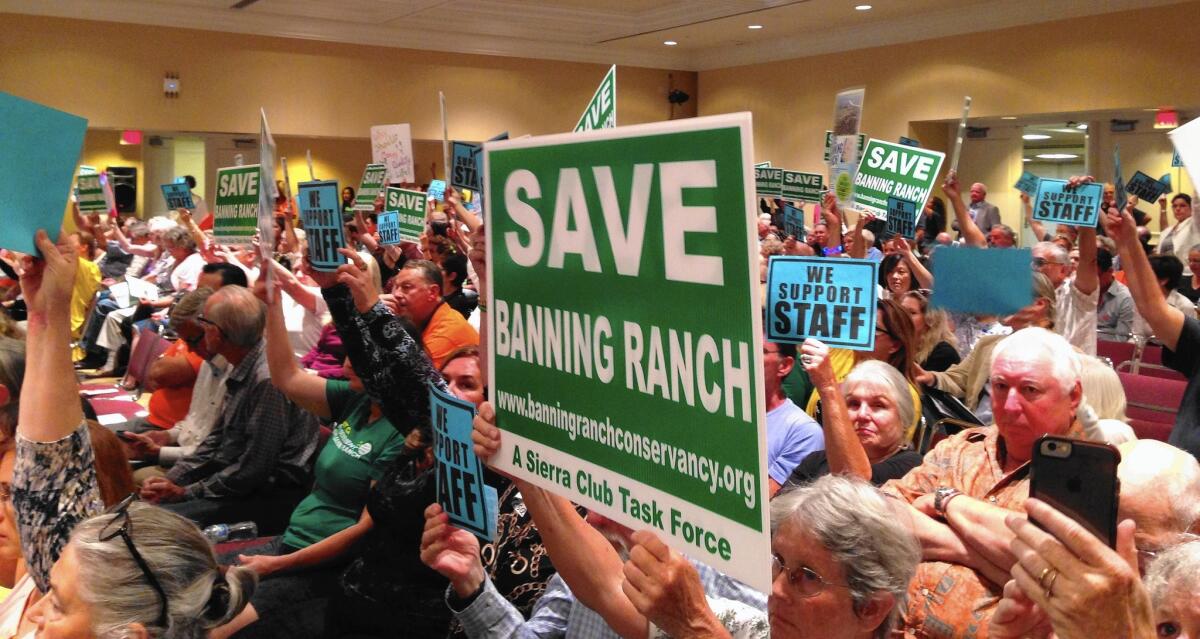Coastal Commission delays decision on Banning Ranch development

- Share via
After more than eight hours of presentations and discussion that onlookers believed to be leading to a denial of the project, the California Coastal Commission opted not to make a decision on the proposed Banning Ranch residential, commercial and parks development.
Instead, developer Newport Banning Ranch LLC opted for a postponement of the commission’s decision on the permit for 90 days. The commission voted unanimously in favor of postponing.
Newport Banning Ranch is proposing to build 1,375 homes, a 75-room boutique hotel, 75,000 square feet of retail space, a hostel and several parks on about 95 acres of the 401-acre expanse adjacent to the Santa Ana River overlooking West Coast Highway.
The time will allow Newport Banning Ranch LLC to work with Coastal Commission staff to possibly devise a plan that could eventually see commission approval.
While the commission agreed that the project was not yet ready for approval, several commissioners including Wendy Mitchell acknowledged merits to the project including opening the land for public use and condensing oil operations that have long consumed the site.
“There is definitely a project here,” Mitchell said. “I’m hopeful that eventually we can get something that will make everyone a little unhappy and everyone a little happy.”
Staff and commissioners suggested in the report that they would likely favor “less-intense” development for the property.
Newport Beach and Costa Mesa residents who have spent the past three years fighting in court and in other public forums for the land to remain undeveloped said the Coastal Commission hearing gave credence to their concerns.
Hundreds of residents from both communities packed the conference room in Long Beach, carrying signs showing their support for the Coastal Commission’s staff, which recommended denying the project. Preservationists waved bright green posters with white lettering reading “Save Banning Ranch,” and homemade signs pictured birds and other native animals on the ranch site.
Another group comprised of several dozen people, some wearing bright orange shirts that read “beyond green,” peppered the crowd to show their support for the development.
Coastal Commission staff expressed opposition to the project as currently proposed during the meeting and in a report, noting that the land is home to “sensitive coastal species” including the threatened California gnatcatcher, a rare vernal pool system and one of the few remaining significant areas of native grassland.
Commission Executive Director Charles Lester said the staff’s recommendation of denial shouldn’t be a surprise to Newport Banning Ranch LLC, given that the developer was “completely at odds and unresponsive with the Coastal Commission.”
Specifically, Lester took issue with the way the project’s environmental impact report was conducted and that Newport Banning Ranch LLC was mostly unwilling to scale down the plans more than it already had.
“The [environmental impact report] was finalized without input from a commission staff biologist reviewing the sensitive resources on the site,” an addendum to the staff report states. “The [report] was approved [by the city] with a statement of overriding considerations, stating that some impacts could not be avoided or adequately mitigated by the project; however, it was approved despite the impacts because it provides economic, legal, social and other benefits to the region.”
Newport Banning Ranch LLC project manager Mike Mohler indicated that cleaning up the land and providing access to the public were important benefits that would be possible only with a project like this. He said the commission had the opportunity to “create something of coastal significance.”
“We think staff got it wrong this time,” Mohler said. “The staff report attempts to ignore the obvious benefits of cleaning up the oil field.”
Commission staff agreed that cleaning up the oil operations was a benefit but was not enough to justify approving the project as a whole.
“These benefits are entwined with substantial impacts to highly sensitive resources and permanent loss of a very rare and valuable ecosystem that cannot be replicated,” the staff report states.
*
History of the project and site
This isn’t the first time the Coastal Commission and the developer have gone head to head over Banning Ranch.
In March, the commission approved a settlement agreement with Newport Banning Ranch LLC and oil companies that operate on the land to end some vegetation removal and oil-well operations that the agency contended affected wildlife.
Newport Banning Ranch agreed not to mow and remove native plants without obtaining a permit through the commission. The developer had agreed two years ago to stop mowing the land after Coastal Commission staff insisted, according to commission documents.
The company, while not admitting liability or wrongdoing, also agreed to remove or seek permits for 17 oil wells that were drilled without Coastal Commission approval and to restore more than 24 acres of native habitat, according to a staff report.
The land that has inspired the intense battle hasn’t been open to the public for more than 70 years. A chain-link fence surrounds the expanse of scrub- and grass-covered bluffs, wetlands, dirt roads and active oil wells.
Peak annual oil and gas production on the site occurred in the early 1980s, with about 1.2 million barrels from more than 300 active wells. Production declined for years until stabilizing at roughly 90,000 barrels from less than 60 wells in recent years.
The site also is known to contain Native American archaeological items.
The controversy over the land has drawn comparisons to the decades-long fight over the Bolsa Chica wetlands in Huntington Beach, where a scaled-down development proposal was eventually approved in 2005.
*
Preservationists want to buy the land
The Banning Ranch Conservancy, a nonprofit group that has opposed development of the site, has butted heads with the developer and the city for three years.
After the Newport Beach City Council approved the proposal in 2012, the conservancy filed a lawsuit alleging that the city had violated its general plan, which prioritizes open space in West Newport.
The conservancy argued that the city did not work with the Coastal Commission in prioritizing specific areas of preservation, in violation of city law. The group also alleged that the project’s environmental report did not detail mitigation measures for the development’s potential effects, according to court documents.
The case has made its way through Orange County Superior Court and California’s 4th District Court of Appeal and will next be heard by the California Supreme Court at an undetermined date.
Steve Ray, the conservancy’s executive director, said that instead of developing Banning Ranch for homes, it should remain open space.
The conservancy has raised about $5 million in an effort to purchase the property and is looking at other funding sources. A 2008 study from the city estimated the property’s value to be between $184 million and $211 million. However, information from the Orange County assessor’s office indicates the land is worth more than $30 million. Ray said no one has been able to put an exact price on the property.
“We’re willing to pay a premium on the price, but first they have to be willing to sit down with us,” Ray said.
Maintaining the land as open space would give native plants and wildlife the opportunity to flourish once again, conservancy members say.
“Nature keeps finding a way on Banning Ranch,” Ray said. “Those are not manmade features, they are man-disturbed features. But they’re still out there.”



